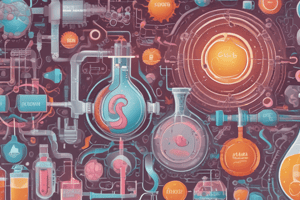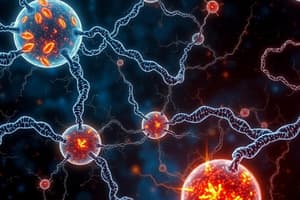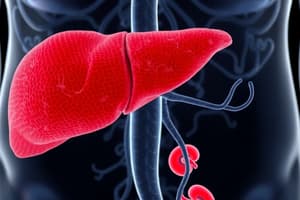Podcast
Questions and Answers
What is the primary purpose of gluconeogenesis?
What is the primary purpose of gluconeogenesis?
- To transport glucose into cells
- To store excess glucose as glycogen
- To maintain glucose levels in the blood during fasting (correct)
- To break down glucose for energy
Where does gluconeogenesis primarily occur?
Where does gluconeogenesis primarily occur?
- In the brain
- In muscle cells
- In the liver (correct)
- In red blood cells
Which of the following molecules can be used to make glucose during gluconeogenesis?
Which of the following molecules can be used to make glucose during gluconeogenesis?
- Cholesterol
- Ketone bodies
- Lactate (correct)
- Fatty acids
Glycolysis maintains glucose levels for approximately how long after eating?
Glycolysis maintains glucose levels for approximately how long after eating?
What is glycogenolysis?
What is glycogenolysis?
How long can glycogenolysis typically provide glucose during fasting?
How long can glycogenolysis typically provide glucose during fasting?
After how many hours of fasting does gluconeogenesis become the primary provider of glucose?
After how many hours of fasting does gluconeogenesis become the primary provider of glucose?
Which enzyme turns lactate into pyruvate?
Which enzyme turns lactate into pyruvate?
Which enzyme converts alanine into pyruvate?
Which enzyme converts alanine into pyruvate?
What is the starting molecule of gluconeogenesis?
What is the starting molecule of gluconeogenesis?
What enzyme converts pyruvate to oxaloacetate?
What enzyme converts pyruvate to oxaloacetate?
What enzyme converts fructose 1,6-bisphosphate to fructose-6-phosphate?
What enzyme converts fructose 1,6-bisphosphate to fructose-6-phosphate?
Which enzyme converts glucose-6-phosphate to glucose?
Which enzyme converts glucose-6-phosphate to glucose?
What process converts glycerol into glycerol-3-phosphate?
What process converts glycerol into glycerol-3-phosphate?
What process breaks down glucose?
What process breaks down glucose?
Where does glycolysis take place?
Where does glycolysis take place?
What is the net production of ATP from glycolysis?
What is the net production of ATP from glycolysis?
The end product of glycolysis enters which process?
The end product of glycolysis enters which process?
What prevents glucose-6-phosphate from leaving the cell?
What prevents glucose-6-phosphate from leaving the cell?
Which of the following is an irreversible step in glycolysis?
Which of the following is an irreversible step in glycolysis?
Flashcards
Gluconeogenesis
Gluconeogenesis
Metabolic pathway using enzymes to create glucose from other molecules.
Glycogenolysis
Glycogenolysis
Breakdown of glycogen into individual glucose molecules.
Lactate
Lactate
Byproduct of anaerobic respiration; turned into pyruvate by lactate dehydrogenase.
Alanine
Alanine
Signup and view all the flashcards
Pyruvate carboxylase
Pyruvate carboxylase
Signup and view all the flashcards
Oxaloacetate
Oxaloacetate
Signup and view all the flashcards
PEPCK
PEPCK
Signup and view all the flashcards
Fructose-1,6-bisphosphatase
Fructose-1,6-bisphosphatase
Signup and view all the flashcards
Glucose-6-phosphatase
Glucose-6-phosphatase
Signup and view all the flashcards
Glycerol
Glycerol
Signup and view all the flashcards
Glycolysis
Glycolysis
Signup and view all the flashcards
Hexokinase
Hexokinase
Signup and view all the flashcards
Glucokinase
Glucokinase
Signup and view all the flashcards
Phosphofructokinase-1 (PFK1)
Phosphofructokinase-1 (PFK1)
Signup and view all the flashcards
Pyruvate
Pyruvate
Signup and view all the flashcards
Oxidative phosphorylation
Oxidative phosphorylation
Signup and view all the flashcards
Electron Transport Chain
Electron Transport Chain
Signup and view all the flashcards
Cytochrome oxidase
Cytochrome oxidase
Signup and view all the flashcards
Acetyl-CoA
Acetyl-CoA
Signup and view all the flashcards
Dehydrogenases
Dehydrogenases
Signup and view all the flashcards
Study Notes
Gluconeogenesis Overview
- Crucial for maintaining a steady blood glucose level and cells using it for energy (ATP)
- Metabolic pathway using enzymatic reactions to create glucose from other molecules
- Uses lactate, amino acids, and glycerol to produce glucose
- Primarily occurs in liver cells
- Takes place in the cytoplasm, mitochondria, and endoplasmic reticulum
Maintaining Glucose Sources
- After eating, glycolysis maintains glucose for roughly 2 hours
- Extra glucose gets stored in liver cells as glycogen
- Glycogenolysis occurs during fasting and breaks down glycogen into glucose in the liver
- Glycogenolysis helps for 12-24 hours
- Glycogen stores are finite
- Gluconeogenesis occurs during fasting, making glucose from scratch
- Gluconeogenesis is the primary glucose provider after 12 hours of fasting
Gluconeogenesis Process
- Converts pyruvate into glucose
- Pyruvate sources include lactate, byproduct of anaerobic respiration in red blood cells and exercising skeletal muscle
- Enzyme lactate dehydrogenase turns lactate into pyruvate
- Amino acids such as alanine (18 of 20 amino acids) can be used to make glucose
- Alanine is the main amino acid
- ALT turns alanine into pyruvate from alanine
Steps of Gluconeogenesis and Key Enzymes
- Pyruvate to oxaloacetate via pyruvate carboxylase
- Oxaloacetate to malate via malate dehydrogenase
- Malate can exit the mitochondria and enter the cytoplasm
- Malate to oxaloacetate via malate dehydrogenase
- Oxaloacetate to PEP via PEPCK
- DHAP leads to fructose 1,6 bisphosphate
- Fructose 1,6 bisphosphate to fructose-6-phosphate via aldolase
- Fructose-6-phosphate to glucose-6-phosphate via fructose-1,6-bisphosphatase
- Glucose-6-phosphate to glucose via isomerase
- Glucose molecule requires glucose-6-phosphatase enzyme
Glycerol's Role in Gluconeogenesis
- Glycerol, a triglyceride breakdown product, is used to produce DHAP
- Glycerol converts to Glycerol-3-Phosphate (G3P)
- G3P then converts to DHAP, continuing gluconeogenesis
Glycolysis Overview
- Is the breakdown of glucose
- Glycolysis occurs in the cytoplasm of all cells
- Glucose attaches to a phosphate group to remain inside the cell
- End product is pyruvate (pyruvic acid)
- Net production is 2 ATP molecules
- Pyruvate enters the mitochondria and then the citric acid cycle (Kreb’s cycle) and the Electron Transport Chain; generates most of the ATP from glucose
Details About Glycolysis
- Glucose breaks down into 2 pyruvate molecules
- Glucose contains 6 carbon sugar molecules
- Pyruvate are 3 carbon molecules
- ATP produces energy
- Glycolysis does not utilize oxygen
- Net production of 2 ATP and 2 NADH molecules
- End products enter the Kreb’s cycle (citric acid cycle) and Electron Transport Chain (ETC)
- One glucose molecule generates 30 to 32 ATPs after going through the ETC
Steps of Glycolysis and Key Enzymes
- Glucose-6-phosphate creation is an irreversible step, preventing exit from the cell
- In all cells, hexokinase helps create Glucose-6-phosphate
- In the liver and β-cells of the pancreas, glucokinase helps create Glucose-6-phosphate
- Fructose-6-phosphate's enzyme is phosphoglucoisomerase
- Fructose-6-phosphate converts from an isomer of G6P
- Fructose-1,6-bisphosphate creation is irreversible, and its enzyme is phosphofructokinase-1 (PFK1); adds a phosphate and is rate-limiting
- Glyceraldehyde-3-phosphate (G3P) enzyme is aldolase
- Two 3-carbon molecules are created
- 1,3 bisphosphoglycerate (1,3-BPG) enzyme is G3P-dehydrogenase
- 3-phosphoglycerate enzyme is phosphoglycerate kinase
- 2-phosphoglycerate enzyme is mutase
- Phosphoenolpyruvate (PEP) enzyme is enolase
- Pyruvate enzyme is pyruvate kinase and the is an irreversible phase
Electron Transport Chain (ETC) Overview
- Final process to produce ATP
- Electrons move through complexes in the inner mitochondrial membrane, to the final electron acceptor oxygen
- Energy is created, moving hydrogen ions from the mitochondrial matrix into the space between the inner and outer mitochondrial membranes, creating a concentration gradient
- Hydrogen ions move down the concentration gradient through ATP Synthase
- As hydrogen ions move, ATP is created
ETC Details
- Inner membrane of mitochondria = oxidate phosphorylation
- ATP made by donating electrons to embedded complexes
- ETC: group of complexes (proteins or lipids) that facilitate the movement of electrons
- Electrons pass from complex to complex, and finally to oxygen; creating a proton gradient (H+) to make ATP
- Two molecules that donate electrons: NADH and FADH2
- Both NADH and FADH2 get oxidized
- Citric acid cycle (primary source and in the mitochondria), glycolysis (In cytoplasm), and fatty acid oxidation (in the mitochondria) are all sources of NADH and FADH2
Steps of Oxidative Phosphorylation
I. Entry - Complex I: Receives electrons from NADH that dehydrogenases create and donates electrons to Complex I. - Complex II: Receives electrons from FADH2 and donates electrons to Complex II. II. Coenzyme Q - Receives electrons directly from Complexes I and II. - Electron carrier to a series of cytochromes. III. Cytochromes - Transfers electrons to the final electron acceptor, oxygen (Final Cytochrome - Cytochrome oxidase). IV. Final electron acceptor V. Proton gradient - An electrical current is generated as the complexes transfer electrons - Complexes I, III, and IV use electrical current to pump protons out of the mitochondria, into the space between the inner and outer membrane creating a proton gradient VI. Complex V - Structure through which the protons (H+) are able to cross back down their concentration gradient - The ATP Synthase is part of this complex - As the H+ pass through, the ATP Synthase phosphorylates an ADP molecule to ATP
- 1 NADH molecule generates 3 ATP molecules
- 1 FADH2 molecule makes 2 ATP molecules
Citric Acid Cycle (Krebs Cycle) Overview
- Electron-rich molecules (electron donors) use NADH and FADH2 to deliver electrons to the Electron Transport Chain
- The Citric Acid Cycle takes place in the mitochondrial matrix
- Pyruvate from glycolysis crosses the membrane from the cytoplasm into the mitochondria
- Pyruvate is converted into Acetyl Co-A by pyruvate dehydrogenase
- Acetyl Co-A is the initial substrate of the Citric Acid Cycle
- Acetyl-CoA molecules can come from other sources besides glucose
Citric Acid Cycle Overview
- Set of 8 enzymatic reactions
- Begins with a molecule called acetyl-CoA
- Acetyl-CoA comes from various sources
- Fasting state: Triglycerides → fatty acids → Acetyl-CoA or Proteins
- Not fasting: Glucose undergoes Glycolysis leads to pyruvate → Acetyl-CoA via pyruvate dehydrogenase occurring in the mitochondria
- One cycle makes three NADH, one FADH2, one GTP
- In the electron transport chain NADH → 3 ATPs, FADH2 → 2 ATPs, and GTP = 1 ATP
- Each Acetyl-CoA makes 12 ATP molecules
- Each glucose molecule makes 24 ATP through the citric acid cycle
Steps of the Citric Acid Cycle and Key Enzymes
- Acetyl-CoA + Oxaloacetate → Citrate via citrate synthase
- Isocitrate via aconitase
- Alpha ketoglutarate, rate-limiting step, via isocitrate dehydrogenase
- Succinyl-CoA via alpha ketoglutarate dehydrogenase
- Succinate via succinate thiokinase
- Fumarate via succinate dehydrogenase
- Malate via fumarate hydrase
- Oxaloacetate via malate dehydrogenase
- Oxaloacetate can then join up with another new acetyl-CoA molecule to begin a new cycle
- Enzymes called dehydrogenases catalyze the oxidation of a substrate.
Studying That Suits You
Use AI to generate personalized quizzes and flashcards to suit your learning preferences.




